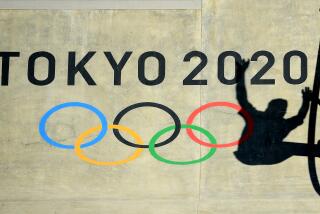JAPAN : Kobe Faltering Despite Hopes : A construction boom has failed to develop after killer quake shook economy.
- Share via
KOBE, Japan — A $170-billion “Phoenix Plan” adopted by the Japanese government to renovate this quake-devastated region so far has failed to reverse an economic downturn here.
“The Kobe economy was heading downhill before the quake, and the decline has accelerated since the tremor,” said Naomi Yamamoto of the Kobe Chamber of Commerce.
Although 70% of the rubble has been removed, a construction boom--widely expected right after the Jan. 17 quake killed more than 5,500 people and inflicted $102 billion worth of damage--has not occurred.
“Even with all these buildings destroyed, we still have empty offices,” Yamamoto said. Like other cities in Japan, Kobe overbuilt in the “bubble economy” years of the late 1980s.
Roads and highways damaged or destroyed by the quake continue to be plagued by traffic jams--snarling port activities and reducing tourism. Hotel business has plummeted. Shopkeepers are giving up their businesses, and factories are moving out of the city, Yamamoto said.
Only two-thirds of the shopkeepers have resumed business, a Chamber of Commerce survey found. In the city’s biggest entertainment section, only a third of the shops, restaurants and nightspots that operated before the earthquake have reopened. And residents are also leaving the city.
Yamamoto said 47,000 workers who remain on company payrolls without work--a “reserve army of the unemployed”--are receiving salary supplements from the central government; 23,000 people lost jobs and are receiving unemployment benefits. Those 70,000 people are 10% of the city’s labor force, the chamber official said. Before the quake, the unemployed numbered about 10,000.
Akira Hanaki, of Kobe’s Reconstruction Headquarters, said the city faces the same problem as all of Japan, namely “the challenge of restructuring the economy.” But, he noted, officials want Kobe “to make a breakthrough . . . to become a model, a pilot lab for all of Japan.”
Kobe’s housing situation compounds its problems. Many families who lost their homes cannot afford to rebuild. Other property holders are locked in legal disputes over ownership rights. Still others are hamstrung by authorities who have earmarked 11% of Kobe for anti-disaster programs to widen streets and build parks; city officials are withholding building permits until real estate realignments are carried out.
Masahiro Uehara, from the government’s urban planning division in Hyogo prefecture, where Kobe is located, said officials hope to win residents’ approval for the realignments by year’s end. Construction would then start by March--14 months after the quake struck. Even then, the work “could take years,” he admitted.
Through August, only 12,000 applications had been submitted to build homes, though Kobe said the quake destroyed 157,162 living units there.
Hyogo prefecture has announced plans to ensure that 110,000 more permanent housing units will be built in three years. But both the prefecture and the city have been so busy building 48,300 temporary housing units for homeless families that contracts to build the first permanent homes were not signed until August.
The biggest problem is the reluctance of owners of large buildings to commit to reconstruction, said Gov. Toshitami Kaihara of Hyogo prefecture. He hopes that the “Hyogo Phoenix Plan” will resuscitate the local economy and transform the devastated area in the next decade.
But so far, all the spending--$25 billion in three different budgets passed by Parliament since the quake--has gone into cleanup and repair.
Phoenix programs won’t get under way until budgets for next year are approved by the national and local governments. On Sept. 20, Prime Minister Tomiichi Murayama’s government approved another $14 billion in quake recovery aid in a new supplementary budget to be enacted this fall.
Kaihara said he is optimistic that Kobe will get the $170 billion for the Phoenix program.
The biggest Phoenix project is “New Eastern City.” It will bring together 10,000 housing units, a World Health Organization research center, insurance offices and welfare facilities for the elderly. Other projects include a “super convention center,” an amusement park on a man-made island, an offshore international airport and “information industry” and multimedia projects.
Despite Kaihara’s optimism, the pledges that politicians in Tokyo made right after the quake for a special budget to finance rejuvenation haven’t materialized.
Megumi Shimizu of The Times’ Tokyo Bureau contributed to this report.
More to Read
Sign up for Essential California
The most important California stories and recommendations in your inbox every morning.
You may occasionally receive promotional content from the Los Angeles Times.













